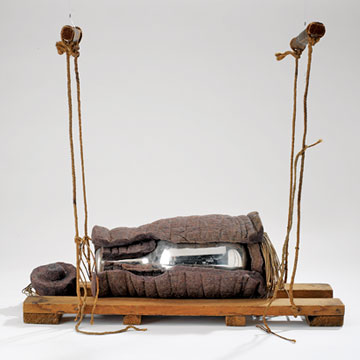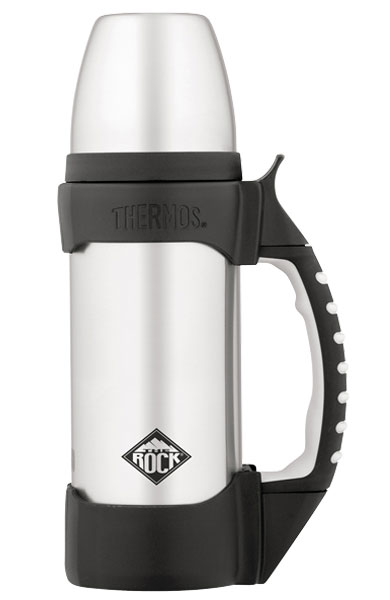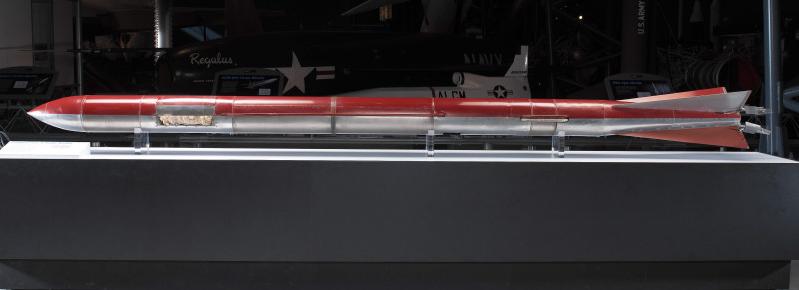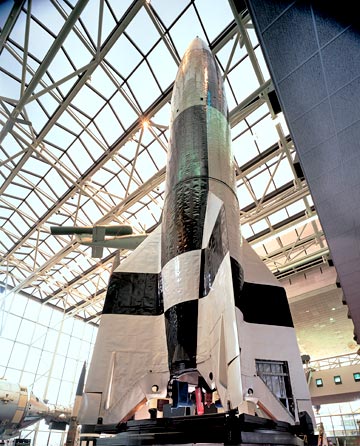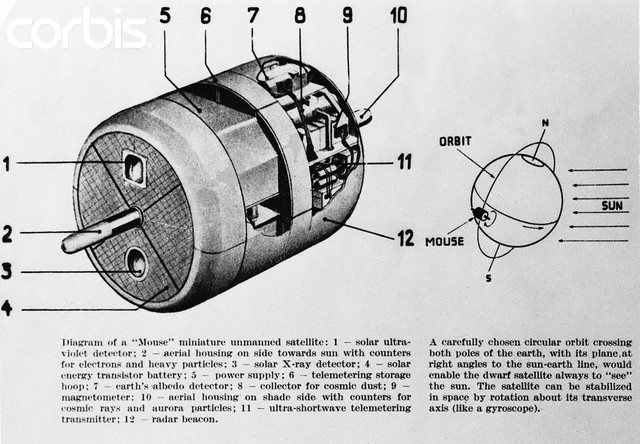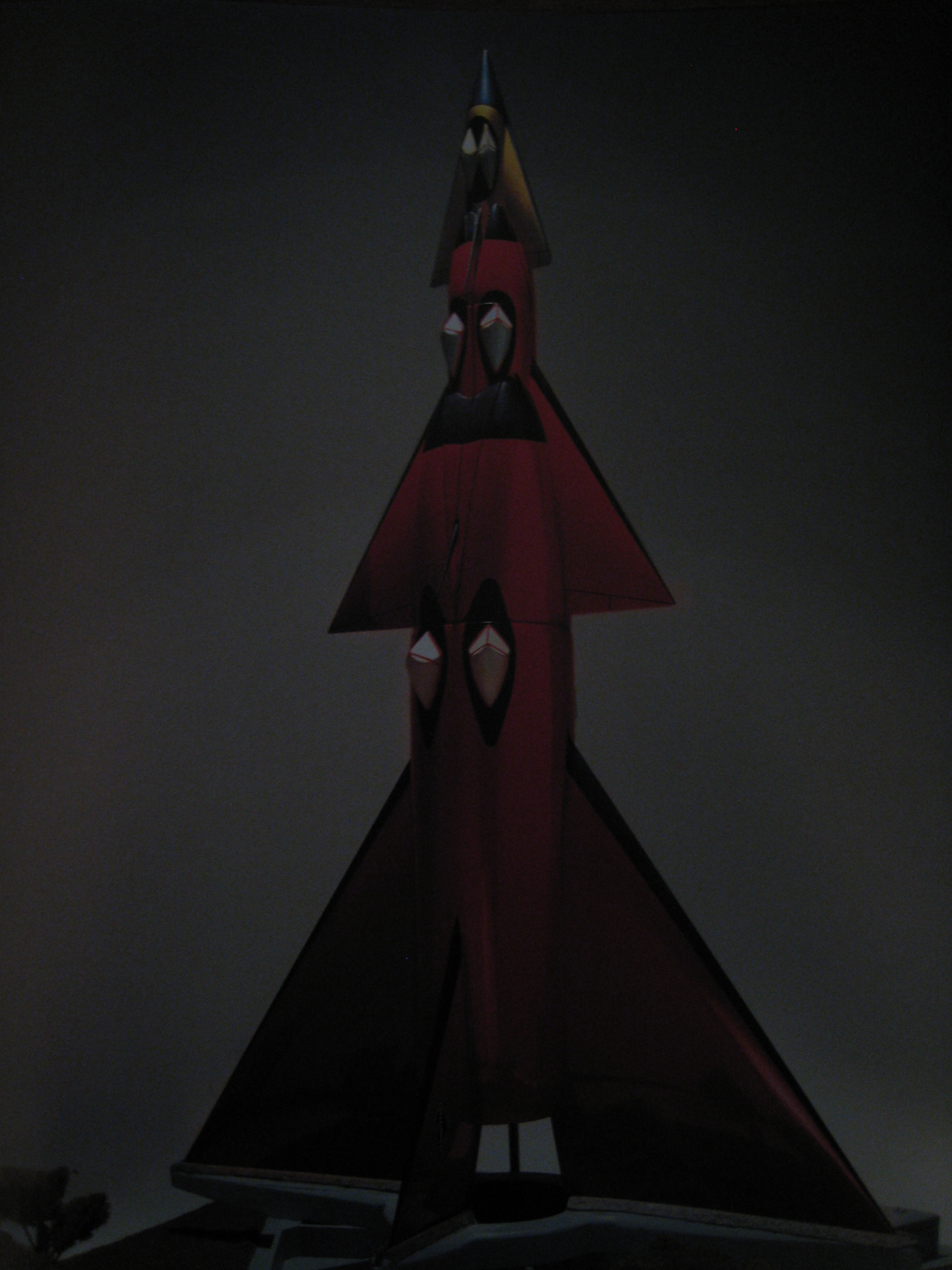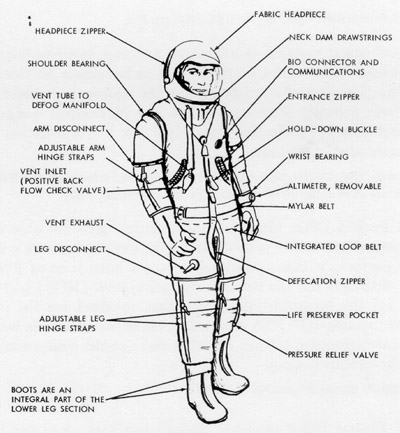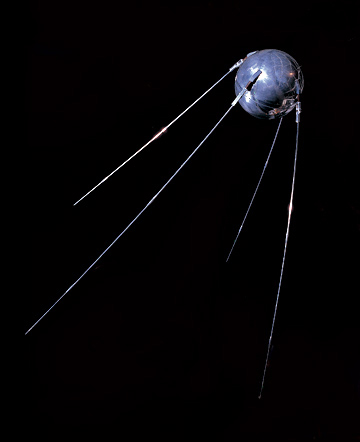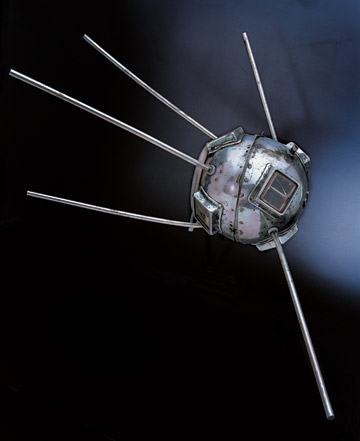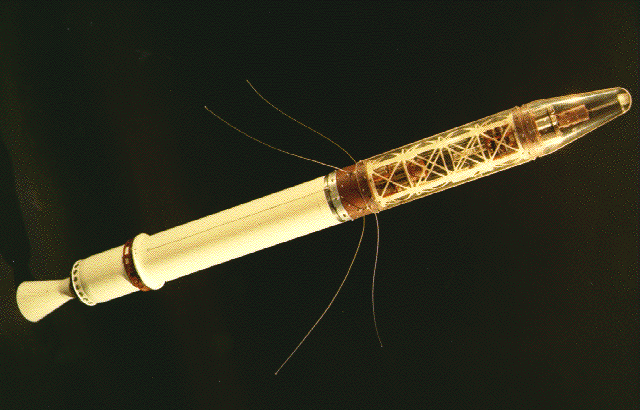|
Robert H. Goddard's Liquid Oxygen Flask and Carrier (1923-1924)This
container was used to hold the “oxidizer” needed whenever using fuel. Together, the
oxidizer and fuel, are called “propellant”. Before this invention solid fuel was used. The main
problem with solid fuel is that you could not shut it off: it burned until the fuel
was exhausted. A Dewar flask is extremely fragile, being made of hand-blown glass. Since the liquid oxygen made the exterior of the flask untouchable cold padding was added around it in order to be handled. These days we use liquid Hydrogen which is kept at far greater temperatures than liquid Oxygen.
"In 1872 the Scottish chemist James Dewar invented a special container that maintains the temperature of either very hot or very cold liquids. This container now called a Dewar flask, is usually a double-layer glass bottle, the narrow space between the walls a near vacuum to prevent the transition of heat. In addition, the inner and outer walls have a silver or other reflective coating to reflect thermal energy. The ordinary Thermos bottle works on the same principle." (Smithsonian)
 |
“One-Stick”
Repulsor Rocket Nozzle (1931)
Efficient
way of directing energy. The nozzle was made by Oberth and his group called it the Raketenflugplatz (Rocketport). This group launched small liquid-fuel rockets into the air 1.5km up and let them come down by parachute. One of the nozzles used for the launches was this one. "Conceived as a part of an all most utopian effort to find
a way to travel into space, instead it led first to the development of the rocket as a weapon." (Smithsonian)
| |
|
Goddard
1935 Series-A Rocket (1935)
It took
some time for Goddard to figure out that liquid fuel would work best, instead
of solid rocket fuel. The Series-A was the first rocket propelled with liquid
fuel. Goddard had been working with rockets since 1909. He experimented with solid-fuel rockets until 1921 when he switched to liquid-fuel ones.
"The Series-A of rockets produced his most successful flights in 30 years of experimentation." (Smithsonian)
|
“Vengeance
Weapon 2”: The V-2 Ballistic Missile (1940s)
The V-2 was not built as a space rocket. Nazi Germany originally designed this rocket to be the world's first ballistic missile; they were looking for a replacement to artillery as that was banned by the Treaty of Versailles. The V02 was
the world’s first, successfully launched, ballistic missile; the ‘harbinger’ of
the most frightening armaments of the Cold War. It all started in 1929 when the German army began to research the rocket as a possibility for a new weapon. This research led to the V-2. 3,225 V-2s were launched during WWII resulting in the death of 7,250 civilians and military personnel. Although the rockets brought terror to all of Europe they were too expensive, for the amount of damage they did, so the German army stopped using them.
"Perhaps no other artifact so elegantly captures the social, political, and military origins of spaceflight than the V-2." (Smithsonian)
| |
|
V-2
Spectrograph (1946-1947)
Was
used to gather data in space, recorded data on photographic film—a medium
vulnerable to destruction but, at that time, one that yielded the best data. The V-2 Spectrographs were launched via rockets out of the Earths atmosphere. The Spectrograph took pictures and recorded data of the sun. The only major challenge faced by Richard Tousey, the designer of the V-2 Spectograph, was retrieving the data. When the rockets returned to Earth they crashed, often damaging most of the film. Touseys solution to this was to blow up the rocket with small charges before crashing to Earth, allowing the remnants (such as the film) to tumble more slowly to the ground.
"The successful flight of the spectrograph in October of 1946 did not change scientists' understanding of the Sun or provide information about the ozone layer, but it did demonstrate that laboratory-quality data could be taken during a rocket flight and retrieved for analysis." (Smithsonian)
|
Minimum
Orbital Unmanned Satellite of the Earth (MOUSE) Mock-up (1954)
A
professor from the University of Chicago, S Fred Singer, wanted to create a
small robotic scientific satellite. In the years before Sputnik many
considered the idea of space satellites with skepticism and assumed that any
possible satellite would have to be large. Singer thought otherwise and
developed a miniaturized satellite. The satellite included telemetry electronics for sending data back to earth along with a magnetic data storage device. 'MOUSE' would be powered by solar photocells, newly developed at Bell Laboratories by Singers scientific colleague John Pierce.
"It weighs about 45 kilograms (100 pounds), contains real Anton Geiger counters for measuring cosmic ray intensity, and sensors for scanning the Earth's cloud cover." (Smithsonian)
| |
|
Snark
Guidance System (1950s)
Was
a robot bomber capable of carrying a nuclear warhead to targets across the
Atlantic. This weapon was inspired by the German V-1. Its guidance system was composed of a
set of gyroscopes and accelerometers that fed data into a computer, which then
calculated navigational position and velocity. The gyros in the guidance system tended to drift and required periodic corrections. Snark did so with a device called 'star tracker', which used the sightings of stars to provide additional information on a missile's position. During development it
encountered a number of problems and was never completed.
"The missile itself may have not been a success, but its guidance system laid the foundation for many long-range aircraft, cruise missile, and even spacecraft guidance systems of the following decades." (Smithsonian)
|
Goodyear
Three-Stage METEOR Jr. Spacecraft Model (Mid-1950s)
Was
one of the first stage rockets designed, but was never built because it was too expensive. The ‘three-stage’ method eventually made its way onto the space shuttle. This system was developed by a Goodyear Aircraft engineer, Darrell C. Romick, to serve as a "practical launch vehicle that you could run like an airliner-the transport of cargo on a regular basis." (Romick) Romick was thinking of developing a working space station at the time.
"METEOR would have cost billions, and it was never built. Looking back, years later, Romick thought that although his idea was "too ambitious," it may have helped plant the seeds of the recoverable booster idea that eventually became the Space Shuttle." (Smithsonian)
| |
|
Navaho
Missile Rocket Engine (Late 1950s)
Created
in the ‘Navaho missile program’, which was split up into three phases:
"In 'Phase I,' they studied V-2 documents closely and interrogated former V-2 technicians. In 'Phase II,' they built their own V-2 engines to learn how to make large liquid-fuel rocket engines. But 'Phase III' of the Navajo programs saw the creation of a completely new and revolutionary type of rocket engine." (Smithsonian)
The engine was a combination of several other
past technologies. Had two nozzles. In 1957, Navaho finally underwent flight
test—none were a resounding success, primarily due to the missiles complexity.
|
Bell
Rocket Belt No. 2 (Late 1950s)
Wendell Moore designed the belt so that it could operate with a noncombusting propellant to minimize risk from heat and possible explosions. Moore impressed the US Army as well as the Marines, but they lost interest in his invention due to its drawbacks. The rocket belt could only operate for about 20 seconds, and it made a lot of noise; making soldiers more vulnerable to gunfire.
"Moore thought more about the rocket as an innovative device for earthly uses rather than its possible applications in space. He conceived of the device enabling soldiers, firefighters, or any rescue worker to leap across ravines, embankments, or other impassible barriers in order to complete a military or humanitarian lifesaving mission rapidly." (Smithsonian)
| |
|
Mark
II, Model “R” Full Pressure Suit (Mid-1950s)
The
suit was designed to deal with a lack of oxygen, extreme cold and pressure.
The suit would prevent blackouts for pilots at high altitudes by providing oxygen, and being pressurized. However one drawback was that it could fill easily with water; not ideal for
Navy pilots who often flew over water.
"The Mark II was one of a series of pressure suits developed by the Navy and B.F. Goodrich through the 1950s, culminating with the Mark V. This line of development proved crucial for the United Sates' human spaceflight program in the first years after Sputnik. The Mark IV suit was adopted by NASA and modified to create the Mercury spacesuit." (Smithsonian)
|
Sputnik
Model (1960s)
Sputnik, developed by Sergei Korolev and Premier Nikita Khrushchev, was the first satellite launched successfully into orbit. The Soviet Union launched it during October of 1957. Sputnik was very small, about the size of a beach ball. The satellite emitted a
‘beep’ on two radio frequencies. The ‘beep’ was powered by batteries. Sputnik ran
out of batteries after 21 days of orbit.
"Sputnik,
launched by the USSR on October 4, 1957, marked a simple, yet profound event in
history: the placement of the first human-made satellite into Earth orbit.
Since that October date, Sputnik has possessed a dual identity, as an icon of
technological achievement and as the starting point for a Cold War Space Race." (Smithsonian)
| |
|
Jupiter-C
Nose Cone (1957)
The nose cone was launched atop a long-range ballistic missile. Its primary purpose was to survive the trip, both, into space and back through the atmosphere, with a
warhead. The cone was coated with a ceramic ablative material, which prevented it from burning up during the trip. This was the first US reentry vehicle to be recovered from space.
"The event (recovering this nose cone from space) proved extremely significant in the development of U.S. space technology. Except for the very earliest ones, all U.S. intercontinental ballistic missile reentry vehicles, as well as the Apollo-era capsules that carried astronauts, used ablative heat shielding." (Smithsonian)
|
Vanguard
TV3 Satellite (1957)
Was
a US effort to set a satellite into orbit. This attempt failed; the rocket lifted its
left a bit but came back down shortly creating a spectacular explosion. This launch was dubbed by the press "flopnik" to rhyme with Sputnik.
"Journalists, pundits, and historians have long debated the meaning of the Vanguard failure. Was it a 'legitimate test failure,' an 'inexcusable example of over publicity,' as a Christian Science Monitor reporter wondered immediately after he launch, or did it represent the United States' 'most humiliating failure'?" (Smithsonian)
| |
|
Explorer
1 (1958)Was the first satellite successfully launched into orbit by the Americans; second try.
Bullet-shaped, some 17 centimeters in diameter and about 1 meter long, the
satellite housed three micrometeorite detectors, temperature sensors, and a
special cosmic-ray chamber developed at the State University of Iowa. Once in
orbit, Explorer 1 instruments transmitted scientific data from its elliptical
orbit for 105 days. It detected varying amounts of radiation at different
altitudes, with an apparent and puzzling absence of radiation when the
satellite was above some 960 kilometers.
"Don't give me any of this probability crap, Hibbs. Is the thing up there or not?" -Maj. Gen. John B. Medaris, 1958 (Smithsonian)
|
|


